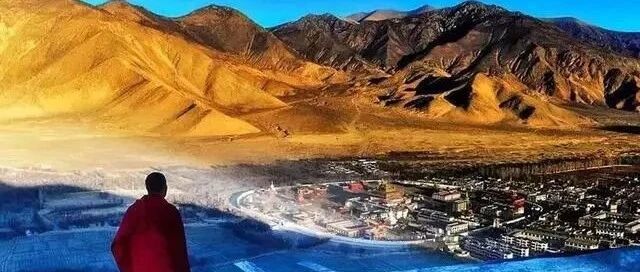
去西藏旅游或者朝圣是很多人的梦想,去之前了解一些民俗风情以及藏传佛教的常识会给您的朝圣之旅增添一抹亮色。藏族几乎都是信仰藏传佛教,所以他们的很多风俗也与信仰佛教有关。
藏传佛教基本常识
西藏的佛教应该称为藏传佛教,藏传佛教密宗派的修行者都需要有很深厚的显教基础才能够进行密法的修炼,所以不能简单成为密宗或密教。其实汉传佛教也有密法的修行。
藏传佛教密宗派主要的宗派有四,格鲁派,萨迦派,宁玛派,噶举派。汉人俗称黄,花,红,白四教,因尊重故建议不要使用,事实上也仅有格鲁派有时自称黄帽派,其他派并不以颜色自称,仅仅是汉人为了方便的称呼。港台流行的黑教,是藏区的原始宗教---苯教,并非藏传佛教的一支,当然更不是佛教,但近年吸收了很多佛教的教义作为他们的新资产,是一个入世间法以及出世间法同时修行的类佛教。
喇嘛这个词,本意为无上,和我们对德高望重的僧人尊称师父类似,堪为师者才称其为喇嘛。在西藏一般称呼出家人叫格隆啦(Gelong 比丘,la 尊称),但是现在基本演变成对所有西藏僧人都称呼喇嘛,即便如此,也绝对没有“喇嘛教”这个称呼。汉地的和尚也一样,和尚,律宗称和尚,乃和合高尚之人,一般是住持或崇高地位之比丘方可称和尚,现在也慢慢演变成见出家人就称和尚,甚至觉得和尚有贬低之义,这都是错误的认知。
祖古---转世者,化身者。完整的来讲就是“乘愿再来的修行者”。我们汉人一般以“活佛”来称呼,这是不合适的。西藏没有活佛这个称呼,佛没有死或活之分,祖古本身也不会说自己是佛,而且不一定是现出家相,有些祖古宁愿在家低调的继续修行之路。第一位祖古转世是噶玛噶举派的创始人,就是我们熟悉的大宝法王,从1193年开始到现在已经是第17世大宝法王转世了,在西藏即使很小的小孩都知道噶玛巴,在西藏拥有最高的知名度。
仁波切,宝贝或珍宝的意思。很重要很尊贵的人或物都可以称呼仁波切。仁波切也不等于祖古,比方说寺庙里的住持就可称为仁波切,但是他不一定是祖古。我们现在只要看到西藏的出家人就随便叫某某仁波切,这也是错误的。
法王,基本只用在少数的几位宗教领袖的尊称,或者已圆寂的几位大师及某几尊护法,西藏绝对没有那么多法王,现在法王满大街的现象是值得大家思考的。
灌顶,很多汉人一听灌顶就趋之若鹜,觉得可以增加功力或者百毒不侵等等,学佛的过程,一有私利的所求,就是错了。灌顶的确有加持,随许,授记,净化等等的意义存在,但是有一套严谨的程序,不是递上红包就可以,师父与弟子之间必须互相观察很长的时间(传统是三年)方可进行灌顶(某些入随许法会或者长寿灌顶例外),弟子本身也需要具备一定的程度才可以接受灌顶。一旦接受灌顶必须终身视其为师,永不背弃或者永不起不敬之心。
藏族人绝对禁吃驴、马肉和狗肉,有些地区也不吃鱼肉,在西藏除了著名的天葬之外,很多平民百姓是采用河葬,所以很多老一辈的藏民是不吃鱼的。敬酒时,客人须先用无名指蘸一点酒弹向空中,连续三次,以示祭天,地和祖先,接着轻轻呷一口,主人会及时添满,再喝一口再添满,连喝三口,至第四次添满时,必须一饮而尽;喝酥油茶时,主人倒茶,客人要待主人双手捧到面前时,才能接过来喝;行路遇到寺院,玛尼堆,佛塔等宗教设施,必须从左往右绕行;在西藏,基本就是顺时针方向行动,这是藏传佛教的习惯,逆时针行进是当地原始宗教---苯教的习惯。经筒,经轮不得逆转;不得跨越法器,火盆;忌讳别人用手触摸头顶。献哈达 献哈达是藏族最普遍的一种礼节。婚丧节庆、拜会尊长、觐见佛像、音讯往来、送别远行等等,都有献哈达的习惯。哈达是一种生丝织品,纺得稀松如网;也有优良的、用丝绸做料的哈达。哈达长短不一,长者一二丈,短者三五尺。献哈达是对人表示纯洁、诚心、忠诚的意思。自古以来.藏族认为白色象征纯洁、吉利,所以哈达一般是白色的。当然也有五彩哈达,颜色为蓝、白、黄、绿、红。蓝色表示蓝天,白色是白云,绿色是江河水,红色是空间护法神,黄色象征大地。五彩哈达是献给菩萨和近亲时做彩箭用的,是最隆重的礼物。佛教教义解释五彩哈达是菩萨的服装,所以五彩哈达只在特定的时候用。哈达是在元朝时传入西藏的,萨迦法王八思巴会见元世祖忽必烈回西藏时,带了第一条哈达回来。当时的哈达,两边是万里长城的图案,上面还有“吉祥如意”字样,故可以说哈达是从内地传入西藏的。还有一种意思是它是仙女的飘带。磕头 磕头也是西藏常见的礼节,一般是朝觐佛像、佛塔和活佛时磕头,也有对长者磕头的。磕头可分磕长头、磕短头和磕响头三种。在大昭寺、布达拉宫及其他有宗教活动的寺庙中,常常可以见到磕长头的人群。磕时两手合掌高举过头,自顶、到额、至胸,拱揖三次、再匍伏在地,双手直伸,平放在地上、划地为号。然后、再起立如前所做。过去,有些虔诚的佛教徒,从四川、青海各地磕长头到拉萨朝佛、行程数千里,三步一拜,一磕几年,有许多死在路途之中,也觉得尽诚尽意、毫无怨言。大昭寺前的粗石板,也被磕长头的人磨光了。在寺庙里.也有一种磕响头的磕头方法。不论男女老少,先合掌连拱三揖.然后拱腰到佛像脚下,用头轻轻一顶、表示诚心忏悔之意。鞠躬 过去遇见长官、头人和受尊敬的人,要脱帽、弯腰四十五度。帽子拿在手上低放近地。对于一般人或平辈,鞠躬只表示礼貌,帽子放在胸前,头略低,也有合掌与鞠躬并用的.对尊敬者合掌得过头,弯腰点头;回礼动作也相同。敬酒茶 藏族在迎接客人时除用手蘸酒弹三下外,还要在五谷斗里抓一点青稞,向空中抛撒三次。酒席上,主人端起酒杯先饮口,然后一饮而尽,主人饮完头杯酒后,大家才能自由饮用。饮茶时,客人必须等主人把茶捧到面前才能伸手接过饮用,否则认为失礼。逢年过节.到藏族家里做客,主人便应敬酒。请喝青稞酒。是农区的一项习俗。青稞酒是不经蒸馏、近似黄酒的水酒,度数十五度至二十度,西藏几乎男女老少都能喝青稞酒。敬献客人时。客人必先喝三口再一满杯喝干、这是约定俗成的规矩,不然主人就不高兴,或认为客人不懂礼貌。或认为客人瞧不起他。喝茶则是日常的礼节.客人进屋坐定,主妇或子女必来倒酥油茶、但客人不必自行端喝,得等主人捧到你面前才接过去喝、这样,才算是懂得礼遇。以上是藏族礼仪中最常见、最普遍的情况,其他还有称呼上的礼节。尊称别人时,-般在他的名字后面加一“啦”字。藏语还有敬语和非敬语之分。用敬语,对尊者或客人说话,表示尊敬对方。其次。在吃饭方面,还有食不满口、咬不出声、喝不作响、拣食不越盘的规矩。行路时,不抢在他人前面,相遇必先礼让。坐时不能抢主宾席、不能东倒西歪,不能随便伸腿等等,这是一般长辈教育子女的一些必须注意的礼仪。西藏的佛教徒把佛看成向诸众生指明究竟真理之先驱者。所以,佛与佛教经典(法)被认为是造就福慧资量之根。诸恶除制于根,就能产生利乐一切有情之善行。为众生康乐而尊佛修法,能持理传播佛法之善知识才能称为僧。佛教的《楞严经》、《三摩地经》、《金刚鬘》等显密经典中,广泛载有建佛修殿、立塔印经等的功德,并提倡一切众生,要为早日解脱苦海,征觉菩提而积德行善。
因此,在西藏,无论是金属制作的佛像、佛经、佛塔、佛殿,还是木雕、塑制、绘制的唐卡以及大小各异之彩绘坛城等等,一旦经由具足功德之法师格西、活佛大德以及僧团开光之日起,统统视为佛的真身,需保持经常上供诵偈,庄严观修。
需要接触某一僧人或大德法师时,必须尊重僧伽礼仪;注意佛前或殿内禁止吸烟、饮酒或酒后进殿;更不得喧吼、放屁,越穿僧队;
佛像经典不得随意搬拿、更不得放在床凳及坐垫上;灯水镜乐和香花果食等供品类、宝瓶铃柞与腰鼓曼达等法器类、坛城面具与彩缎法具类等等,禁忌乱动摆挪,更不得对之近面喘气使供品受污;在集体念经或喇嘛修诵时,禁忌瞪眼或直久视看喇嘛的脸;
高僧大德处,禁忌谈论与佛教有关的文物生意,禁止用庙中文物作成交谋利之言论和行为;
执行公务或采访期间,未得允许之前,禁忌在殿内或僧团中间摆放采访器材,也不能直接与喇嘛和住持访谈;
向僧团发布施时,一般应先持香熏排污气——转香后再进殿发放或委托僧人发放。
接触高僧大德时,首先敬献哈达以示尊敬,哈达只许献在手中,忌献脖或头上;高僧互为拜献,也在手中交换。向党和国家领导人敬献,须先致至高敬礼,然后躬身献于手中,绝不能把哈达献在领导人的脖子上,这是对领导人的一种不敬。只有父母或长辈、师傅给自己子女或徒弟哈达时,才能挂在脖子上。常在电视中见到,连小小演员都把哈达献在国家领导人的脖子上,这十分不敬,是缺乏文化修养的表现。佛塔。塔,系梵文塔波的略称,意为坟或高显物。佛塔建筑初兴于佛灭后的第四个百年——印度阿育王时期(相当于我国秦始皇时期),本来内藏灵骨的才叫塔,不藏的叫作支提,但后来都称为塔,而把藏遗骨的称为灵塔。随着佛教广泛传播而与各地文化融合,形成形状和大小各异的佛塔文化。
当我们处在佛塔周边时,禁忌取用信徒献给塔上的任何供品;
在塔前诵经或磕长头、绕塔,禁忌拥挤和争抢先行,应循序而进;
路过寺庙、佛塔以及玛尼堆、经旗杆时,都应顺时针方向绕行;
藏文、汉文或其他任何文字中带有佛法内容的字都应妥为保护,禁忌撕碎抛弃,更不得作卫生纸用;禁忌携带佛像、佛经以及有关法物上厕所。密宗类
西藏密宗佛像中,有独具色彩之忿怒像、双身像、多臂多面像、一面多臂像、息态平正像等中的怖畏、明王、金刚等,分别代表佛、菩萨、护法的四大功业,并含有密宗文化艺术特征,形成为西藏密宗的神秘色彩。
在双身像或密宗忿怒像处,禁忌谈论对佛、菩萨不敬之言论;
行进人密宗殿堂或护法神殿,尤忌观看护法神的秘密部位,因为护法神最容易受污而失散神智。
无论是护法神殿,还是念诵护法的喇嘛或法师处,一般禁止寡妇、月经期的妇女逗留。
密宗戒中专门有一条规定是,若不尊重女同胞,按犯一次密戒看待。所以,这不是对女同胞的歧视,而是为了保持护法神的清净和不受干扰。
由人的头骨制成的“嘎巴拉”、男女头骨制成的腰鼓、人骨所制的念珠以及未满18周岁女子的大腿骨制成的骨号等等,都是密宗中最受保密和最为神圣的法具。这类法具,只有具大成就的密宗上师才能持用,作为对鬼神施行供养、发布指令和观察人生无常等高层次修密时所用,一般人决不允许持拿,更不能对这类法具有不敬之言。
密宗认为,一般杀生与密宗师用放密咒杀生的性质完全不同,其因果报应也不一样。因此密宗十分讲究戒律之保密。密宗佛像一般都用哈达、缎绸包裹,原因也是禁忌俗人偷看护法神的密部的意思,这点在参观密宗殿佛像时一定要严格遵守。
尤忌在寺内谈论两性关系的话题,以免违背宗教政策和伤害修密喇嘛的宗教感情。杀生是整个佛教禁忌的主要内容。而西藏的现实中,宰杀牛羊又是维持生活的必备方式,很难禁忌。雪鸡的羽毛色彩艳丽,被认为是贤劫千佛之灵鸟,杀一只雪鸡,就有毁千佛之罪。因此,特别忌杀雪鸡。
天葬。西藏一直把老鹰视为神鹰,有的地方还认为是无量光佛的一种化身。天葬时,请喇嘛念经并请有经验的天葬师,按仪轨将整个尸体肢解,骨头砸碎,和起来喂老鹰吃,表示死者最后还把自己仅有的肉身布施给了其他生灵,必获无量功德;而且神鹰还能把他的灵识带到极乐世界,从而摆脱轮回之苦。其他民族对这种葬礼方式一般很难理解,但从西藏的传统观念,尤其是从佛教思想来看,则是非常容易理解的自然行为。民俗文化中,禁忌围观天葬和伤害神鹰也是重要内容之一,因而西藏自治区政府已明令公布禁止参观和拍摄天葬活动,禁止猎杀和伤害鹰鹫。对天葬师赠送给我们的任何物品,不能产生厌恶或疑念;尤忌在采访或与天葬师交谈时,有不符葬礼仪轨和不尊重其人格之各种言论。
在西藏南部峡谷地区,山高谷深,加之气候炎热,鹰很难上来,因而多采用水葬,将尸体肢解喂鱼。但在多数藏区,水葬只是经济条件十分困难者才采用。有名望的大活佛和高僧则采用塔葬(建灵塔),一般活佛、高僧和社会名人采用火葬。恶性传染病患者和重大罪犯,死后只能挖坑掩埋,不立墓碑,以示惩处。还应该说明的是,西藏的门巴族和夏尔巴人虽也信仰藏传佛教,但却不流行天葬。夏尔巴人和登巴人多实行火葬,门巴族和珞巴族多实行水葬。
无论是天葬,还是水葬、火葬、土葬,当送葬人回家时,在门口要按顺序用白黑水洗手除污后才能进屋;死者家人布施的各种礼品也要燃香熏污,使之净化后才能使用,否则将会致害死者。为死者带孝,也有不同方式,一般带孝人49天之内不戴帽、不理发、不穿新衣、不参与娱乐活动,妇女不更换头饰。在家除做法事活动外,每天还应举行向死者送食的烧施仪式。为父母或上师带孝,孝期一般为一年,带孝人一年内不穿新装,更不参与与佛教无关的娱乐活动;在带孝人处,禁忌提起死者的名称,尤忌与死者家人一同观赏死者照片和声相物品。
烧施,是给诸神或饿鬼的一种祭祀。在自家的屋顶、高山顶、草原或任意其他地方“偎桑”,也是给神鬼的祭祀。在风马旗杆、鄂博(指在山顶或石堆上,插上小旗,求神保佑往来行人)、嘛呢石子堆等处,除举行“煨桑”仪轨外,禁忌胡乱吼叫或鸣枪。家中有病人或未满月的婴儿以及有喇嘛作佛事时,门前点燃一堆小烟火,表示禁忌一般客人进人;当贵客、亲属进屋时,需先用燃着的松柏熏烤去污后方可进人。小孩出门,在鼻尖上点一些锅灰,以防魔鬼致害;家人很晚回家或出远门回家,甚至带别人送的礼品回家,同样也要熏香去污后才能进门。禁忌在长年患病或危重病人身边放声闲聊,或长时间停留。活佛、喇嘛闭关修行时,门口有一块小木板或一个泥团,上插柏树枝,周围摆几颗小石子,称闭关石。表示修行者不得越此界石外出,除最亲近的固定人外,任何人禁忌进人界内。当我们采访或执行重要任务时,须先经闭关者准许后方可进人,并需把泥团周围之一颗小石子带放在闭关者跟前,才可开始采访。西藏平常有忌时之说,一般每月的初一、五、十、十五、二十等为白日;初二、四、六、十二、十六、二十六等为黑日。白日主吉,可以从事法事、修殿、盖房、举行婚礼、商谈生意等各种活动;黑日主凶,一般忌谈各种盛事,或出门办大事。藏族婚姻,有许多讲究,几乎各地区都有不同的婚礼方式。在一般情况下,男女双方相爱,除了解家庭经济状况等外,还要观察双方的属相是否对合,双方家庭供奉的护法神是否相合,若发现家中供神不一,属相不合时,一般双方父母不同意搞恋爱,更忌结婚。僧尼出家以后,均须起教名,不再沿用俗名。多年患病或家庭不和等常遇灾难之男女老少,除正常治疗外,也有请喇嘛作法事并改换名字的作法;改名以后则禁忌称呼前名,否则会导致不快。藏族人在13、25、37、49、61、73等虚岁时,处在本命年,也是厄年,一般不出远门,禁忌参加娱乐活动,尤忌参与婚礼或葬礼活动。藏族人平常在家中做饭时,禁忌用勺子尝味,尤忌用勺子直接喝水后将剩下的水再倒人缸中,以免因给护法神的供水不净而导致灾难。吃饭、喝茶、喝酒,一般忌讳大口猛喝和发出响声,而且忌讳自己去取用,应由主妇斟人。喝茶、酒时不能只喝一杯,认为一杯成仇人,须喝三杯以上才吉祥。
家中供奉的佛堂,未经准许,不得私自观看,以免触怒神佛而带来灾难。
西藏一般禁忌借他人衣帽,尤其是寡妇、鳏夫之衣帽。若必需借用,则需在借和还时先熏香去污,否则会带来晦气。
借用别家扫帚后,归还时只能当面摔在地下,切忌直接递人人家手中。
西藏的节庆活动,来源多与宗教有关,经历史演变,多数已形成以民族节日活动为主,少数的以宗教活动为主。如拉萨的祈愿法会(传大召)和酥油花供(燃灯节);另外,各教派、各地方也都有一些区域性传统宗教节庆活动。拉萨的祈愿法会不仅是西藏全区性的活动,而且所有信仰藏传佛教省区的僧俗群众在经济条件允许时,也多以能亲往参加朝佛和观看格鲁派最高宗教学位拉让巴格西的考取过程为荣。而祈愿法会结束时的正月十五酥油花节(灯节),八廓街摆满各寺庙及各地民间艺术家用酥油制作的各种佛像、天女和故事传说中的图案、人物、花草、鸟兽,更是精彩多姿、玲珑剔透,人们在酥油花架下,欣赏赞叹,欢庆起舞,彻夜不眠,体现人们对生活的热爱和美的追求。参加这类活动时,应注意有关禁忌,内容基本和参加其他宗教活动时相同。在世界上不同的宗教,文化圈内,都有各种不同的宗教祈祷方法,或者说宗教祈祷仪式。
在藏传佛教文化圈内,祈褥仪式与藏族群众的生活联系是非常密切的。在整个藏区最有影响的英雄史诗《格萨尔王传》中,可以看到许多受藏传佛教影响的祈祷词,这里试举《天界篇》中的一段祈祷词:
“唵、嘛、呢、叭、咪、吽。顶礼无边世界的救主前,西方极乐世界估主光不变。你的悲心无偏袒,不净的轮回也是照见。在那轮回的大苦海,专嗜杀业的恶鳌出现。可畏的五毒起狂斓,明镜之心被障成盲者。生死无极真可叹!请发慈悲示以善巧方便。”佛教在藏族地区流传已有一千多年的历史,古老的雅鲁藏布江一年复一年流过这块神奇的土地,人们一代又一代,踏着前人的脚印,去拉萨、后藏、冈底斯神山、玛珐木措湖、佛之净土墨脱等地朝圣祈祷还愿;一天又一天,口诵祈祷经文,手摇转经筒,在漫漫转经道上,走呀走呀,以达到免除罪愆,获得超度。
祈祷一词在藏词中称为“默朗斗巴”(Smon-lamvdebs-pa),意为发愿、祈愿。公元1409年,藏传佛教之黄教创始人宗喀巴,为了纪念释迎牟尼,在拉萨大昭寺倡建了一次讲论佛经、发愿祈祷的宗教法会。藏族人称为“默朗钦摩”,俗称传大昭,参加这次发愿祈祷大法的僧人有一万多人,可以说传大召是西藏最大的僧人集体析祷仪式。直到今天,这种规模宏大的集体祈祷仪式,每年的藏历正月都要举行一次。祈祷的内容包括祷祝佛教发达,常驻世间,有情安乐,天下太平等。据记载,抗战时期,甘肃最大的黄教寺院拉卜楞寺,就曾在这种祈祷法会上,特别举行了“祈祷抗战胜利并扩大宣传”的仪式。藏族地区除了口诵祈祷经文和六字真言外,还要借助于祈祷法器等来进行祈祷仪式,这正是藏传佛教不同于世界上其它宗教的地方。祈祷法器藏语称“嘛呢轮”,“嘛呢”二字即六字真言的简称,从佛学涵义上讲,祈祷法器“嘛呢轮”实质上是六字真言“唵、嘛、呢、叭、咪、吽的象征。“嘛呢轮”之形如圆桶或轮,上有六字真言字样,藏传佛教认为,转动“嘛呢轮”与口诵六字真言具有同样的功德,如果二者同时进行,那业力更增。因此,“嘛呢轮”又称“转经轮”或“转经筒”。包括下面数种:
4.手摇转经筒,藏语称为“嘛呢那廓尔”。分金铜银皮制数种,有大中小三类。小者高二寸,直径三寸半,圆桶中有轴可转老年人多持手摇转经筒,且行且摇且诵,待到中轴磨坏,则为功德圆满。
5.嘛呢轮,藏语称作“嘛呢廓尔洛”。形如桶,内有轴可转。这种嘛呢轮大多装置在寺院四周或寺院大殿的四周(拉萨大昭寺的嘛呢轮则是在寺内),少则数十,多则数百,其表面记有六字真言,其中又满贮经典。当信徒或僧人路过时。用手转动经轮。藏传佛教认为,只要转动一次经轮就等于将经轮中所藏的众多经文诵读一遍。
除了运用上述几种转经轮进行祈祷外,藏族地区还要通过一些特殊的方式来进行祈祷:
1.祈祷幢,藏语称为“隆达”,即将祈祷词印写在各色布旗上。以竿揭之屋顶,使风吹之,也为祈祷。
2.祈祷壁,在金木板上携刻六字真言,挂在壁上,也是祈祷之一种。
3.嘛呢堆,藏语称“嘛呢多朋”。凡是过往要道,要把刻有佛教六字真言的嘛呢石块垒砌成堆,过往行人都要绕嘛呢堆转上数圈,籍以祈祷和积功德。
4.转山、转神湖等,藏族信徒和僧人在朝圣时,每遇神山或神湖时,一般都要绕行一周这也叫转嘛呢,即转经,其内涵如同祈祷,其功德往往大于寻常祈祷的千万倍。西藏南部珞隅地区的杂日神山,被认为是佛教密宗上乐金刚之圣地,最上密宗之 。十二世纪末,藏传佛教噶举派之大德藏巴甲热·益西多杰首创了杂日山祈祷巡转之例。据称,世人能绕此山顶转一次,需三日可得六字真言十三亿之功德;绕山腰转一圈,需十日,可得三十亿六字真言之功德;绕全山一次,需一月,则可得一百亿六字真言之功德。拉萨是藏传佛教的圣城,城内有三条专供信徒祈祷转经的环行道,世称“朗廓尔”(内转经道)、“帕廓尔”(中转经道)、“林廓尔”(外转经道);信徒坚信在此三道祈祷转经,功德是非常圆满的。因此,从黎明到日落,转经路上都可见到手摇转经筒的信徒。